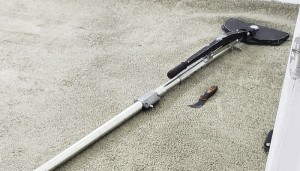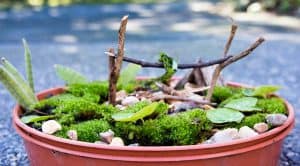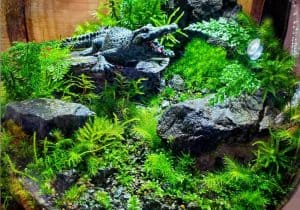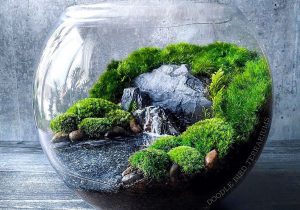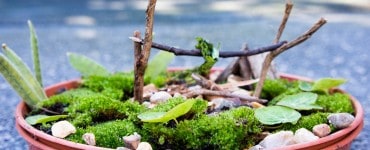Terrariums open up a world of indoor gardening opportunities for folks living in tight spaces or apartments and condos, bringing in a little bit of extra greenery to spaces that might have felt a little cold and a little sterile otherwise.
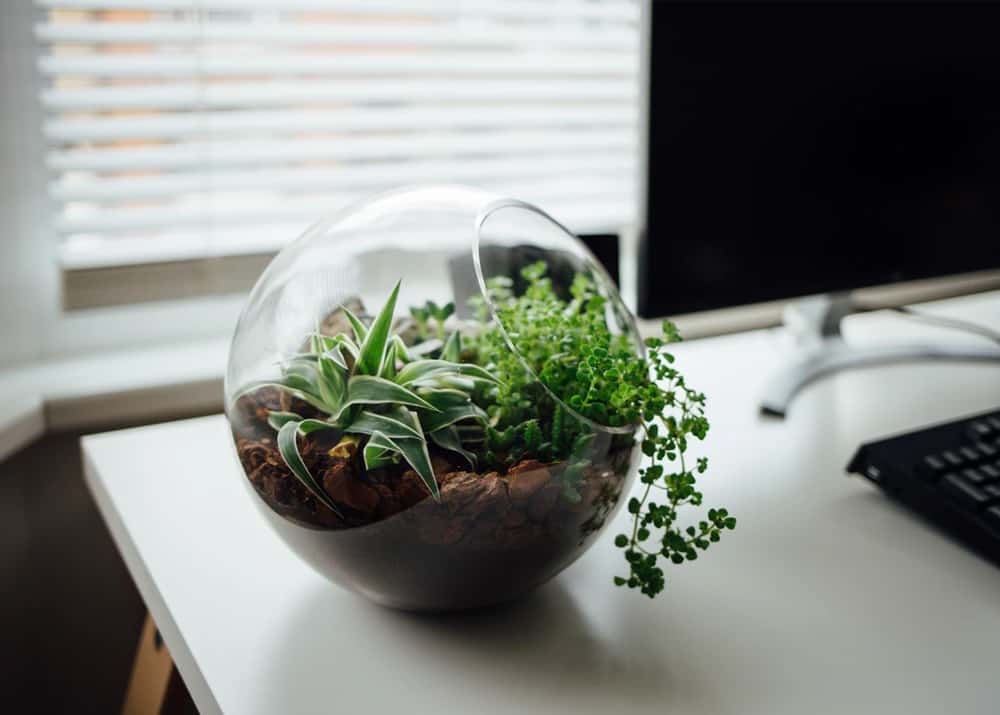
Super low maintenance, you definitely do not have to have a green thumb to take care of terrarium plants – that’s for sure!
Best of all, you’ll always be in complete and total control of how your terrarium looks, the size of your terrarium, and how your terrarium grows and evolves over time.
The only thing you’ll have to do is tackle how you want to establish your terrarium plants moving forward – choosing the right air plants, aquarium plants, and plants that will succeed in a closed container – but after that everything is pretty much “set it and forget it”.
What Makes Terrariums So Special?
There are a couple of things that make a terrarium so special compared to more traditional indoor plants, with the most obvious thing being that you don’t have to spend anywhere near as much time caring for a terrarium as you would have to care for potted plants you pick up at a farmers market or nursery.
Instead, terrarium set ups are their own little self-contained world under glass, giving you an opportunity to create your own miniature forest, tropical environment, or desert scape (it’s entirely up to you) in a way that just isn’t possible with more traditional indoor plants.
Best of all, you do not have to be a landscape designer to make the most of everything that the organic gardening of a terrarium has to offer. Though there are a number of terrarium kits you could pick and choose from plenty of people start from scratch with nothing more than a grow light, some golden club moss, and maybe some potting soil and plants to grow – with everything in their terrarium taking off from there.
Another thing that makes terrariums so unique from any other indoor potted plants set up is the fact that you are going to have a chance to see the entirety of a plants world grow, develop, and change in a way that’s just not possible with potted plants.
When you put pots into a planter you only ever get to see what grows out of that soil. But because terrariums are (usually) created inside of glass containers with total transparency you’ll get to see how the root system works, how the soil is changed by these plants, and how the full cycle of life is so important to your terrarium plants. You gain x-ray vision of sorts into a part of nature that you wouldn’t have been able to enjoy otherwise.
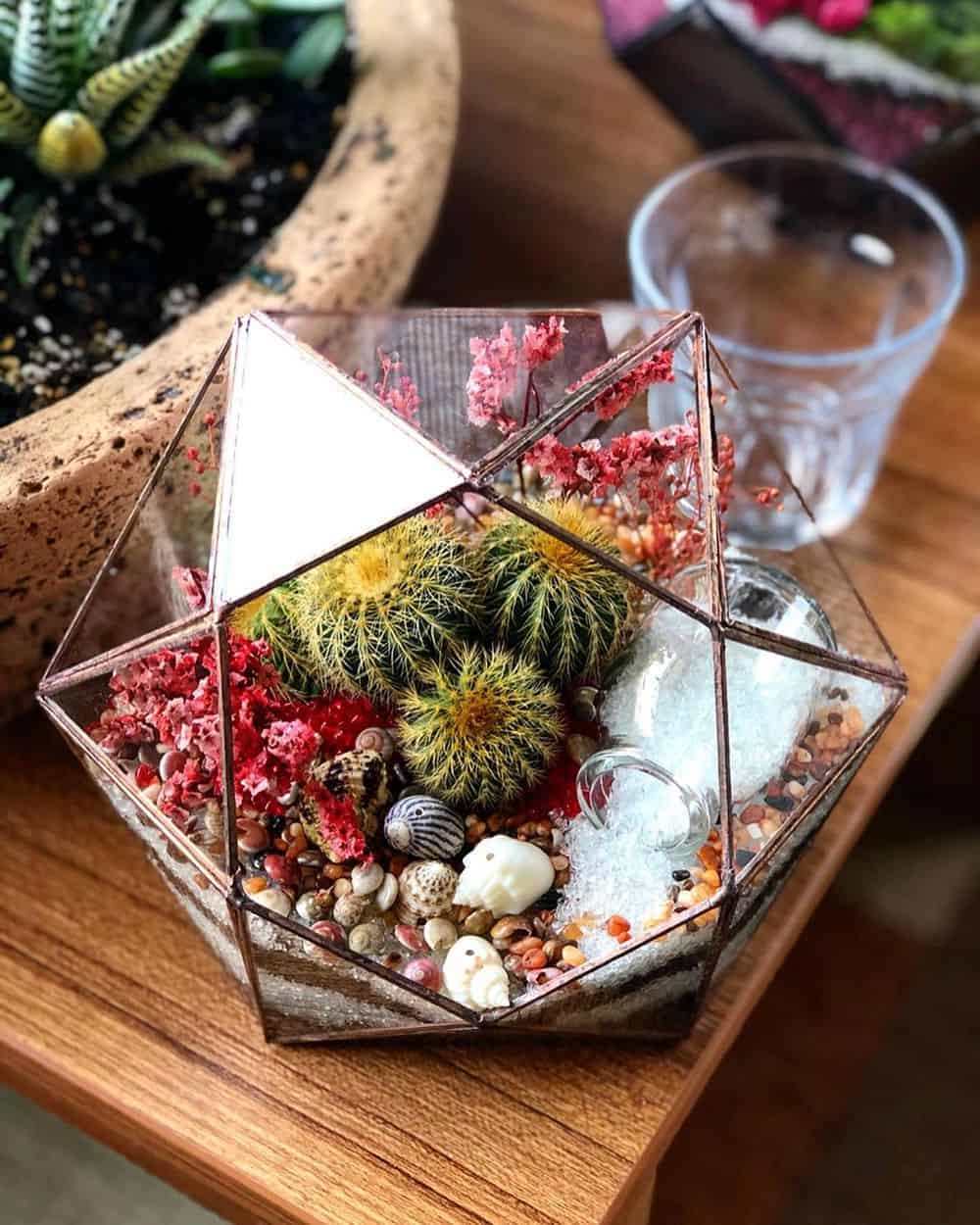
The other big advantage we want to highlight is the fact that you will be able to grow so many different kinds of plants inside of a terrarium that might not have succeeded outside of these closed environments.
Terrariums aren’t limited to just soil based plants. You can grow air plants, succulents, cacti, and water plants inside of these little controlled ecosystems, too. There are a lot more opportunities to tinker around with Mother Nature when you get your terrarium set up the way you like it, that’s for sure.
Breaking Down the Two Types of Terrariums
The whole concept of a terrarium was first created back in 1829, when a botanist by the name of Nathaniel Ward “discovered” terrariums on accident.
What happened is Ward sealed a moth inside of a glass jar that contained a little bit of damp soil and when he went to check back on the specimen a week or so later a tiny little fern had started to establish itself under the glass.
Ward noticed that there was a bit of condensation occurring during the day that disappeared during the night, suggesting that there were little “rain clouds” that were self-perpetuating and feeding the soil – and the fern – without any outside interference necessary.
Ward started to share his funny little accident with other people, and before you know it terrariums had become a big hit throughout Victorian England and then spread through the rest of Europe and later the world. Not only were these terrariums used as decorations but they were also used as a very popular method of growing and transporting plants that might have died if left exposed to outdoor elements.
The whole idea of a terrarium really took off in the 1970s in the United States and these desktop gardens and coffee table jungles have been red-hot popular ever since.
Today terrariums can be broken down into two different and distinct types, however.
Closed Terrarium
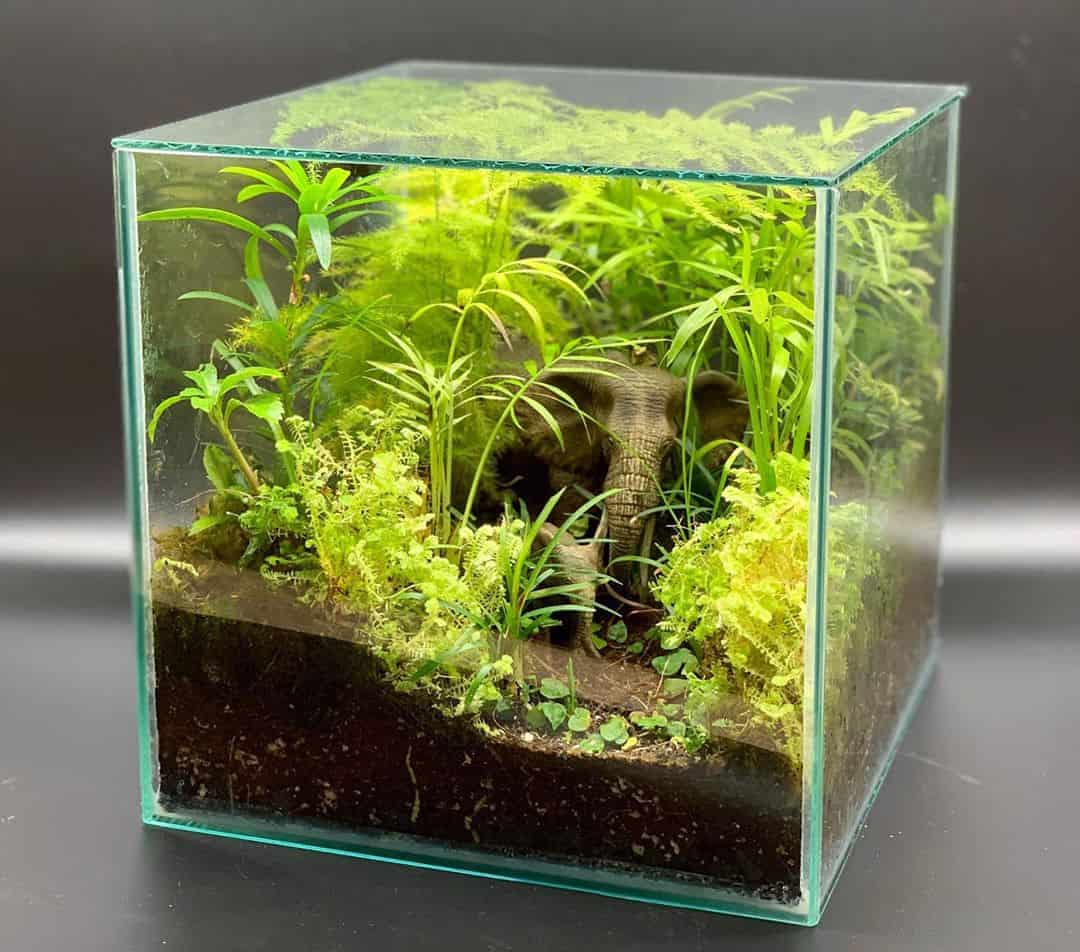
On the one hand you have a closed terrarium that is established inside of a (no surprise here) completely closed environment. These kinds of terrariums really excel with terrarium plants that soak up humidity and love extra moisture.
Open Terrariums
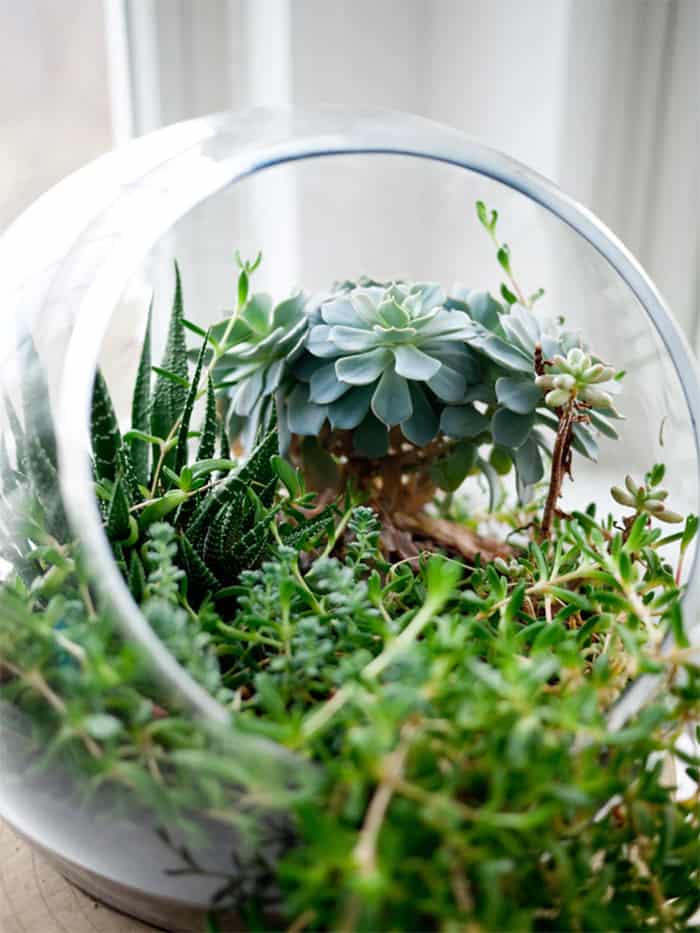
On the other hand you have open terrariums that are created (again, no surprise) inside of open or semi open glass containers. These kinds of terrariums allow for extra air circulation and sunlight and are best suited to plants that do not need as much humidity or moisture to grow and thrive.
No one type of terrarium is better than the other necessarily. It really all comes down to figuring out what types of terrarium plants you want to grow and then choosing the right container or environment type to give that garden the best opportunity to flourish.
What Will I Need to Build a Terrarium?
There are a couple of supplies you are going to need to gather if you want to create your very own miniature garden under glass, but you don’t have to worry about spending a mountain of money or trying to track down hard to find supplies when creating a terrarium.
In fact, the odds are pretty good that you’ll be able to find everything you need to create a terrarium that will set your interior design project apart from the rest of the pack at your local department or hardware store with zero difficulty at all.
The internet will be your best friend to source unique containers and terrarium extras, too – almost always at very affordable and attractive prices.
To hit the ground running with your own terrarium you’re going to need to get your hands on:
A closed or semi close container made out of high quality plastic or glass materials, ideally completely transparent to allow for the most sunlight to get through
- The terrarium plants of your choice, with an almost endless amount of options to pick and choose from (some of the best we highlight below)
- Potting soil that is rich in nutrients to support the growth of your tiny little garden under glass
- Activated charcoal (this is hugely important)
- Tiny little decorations and embellishments that you want sprinkled throughout your miniature garden display
- A bottle of spray water that you can use to moisten your garden before you seal it up
- Tiny little tools (like chopsticks, tweezers, etc.) that let you move and manipulate the smaller parts of your garden without damaging or disturbing other areas
Obviously, there are other things you can track down to add to your terrarium if you decide to go in that direction. But for the most part all you need to get this project going are the supplies we have highlighted above, a little bit of time (say a couple of hours on a lazy weekend), and your own creativity!
One of the coolest things about a terrarium is that it can be built on almost any budget. Your project can grow or contract depending on how much you’re willing to spend without handicapping your creativity in any way.
Plastic is a very popular option for terrarium creations that are going to be built and put out in interior design projects with a lot of foot traffic or where visitors may accidentally bump into these tiny little gardens.
Glass, on the other hand, is going to offer you a much more “high-end” aesthetic appeal than even the finest plastic options could. If you’re going to want to make your new terrarium a real centerpiece and focal point of an interior space is not a bad idea to splurge a little extra a glass container to support the microscopic garden you’ve created inside.
What Terrarium Plants Work Best?
As we alluded to earlier, you are going to have absolutely zero trouble whatsoever finding plants to fill your terrarium.
There are a couple of things you’ll need to consider before you go shopping for these plants, though, important considerations that we touch on below that should inform your plant choices pretty significantly.
For starters, you’re going to want to figure out how many plants you want to grow inside of your terrarium. Different plant species may have different requirements for their environments, may not “play nicely” with one another, and may not be all that aesthetically pleasing when combined inside of a terrarium environment.
Secondly, you’ll want to think about the frequency of watering that your terrarium plants are going to require individually and collectively. Consider the amount of humidity required, the amount of sunlight that they will need, whether or not air circulation is critical, and the type of potting soil that they all will excel in.
Here is a quick rundown of some of the most popular terrarium plants out there on the market today, plants that really work well in these kinds of environments (and look great, too):
- Air plants
- Babies tears
- Birds nest ferns
- Creeping figs
- Different kinds of cacti
- Moon valleys
- Nerve plants
- Prayer plants
- Starfish plants
- Succulents
- Victorian break ferns
Other plants are going to work well in a terrarium environment, too but these are sort of the “bedrock” plants that we found really shine when tucked under glass (or plastic, as the case may be).
Tips and Tricks for Caring for a Terrarium
It will be next to impossible to find a person on the planet that thinks terrariums are difficult to take care of.
Taking care of a terrarium is as simple and as straightforward as understanding the basic needs of the plants that you have chosen, providing just a little bit of water and just a little bit of sunlight – and that’s only for terrariums that are semi open.
If you have created a completely closed terrarium all you really need to do is sneak them into the sunlight for a couple hours every day and they really are “set it and forget it”.
With open terrariums, however, it’s a good idea to check on the water level of the soil every week or so. You can do this just by touching the soil with your fingers to see if it feels dry and crackly. If that’s the case, spray some water into your terrarium to gently moisten the soil and you’ll be good to go.
If at anytime you see mold growing inside of your terrarium (opened or closed) you’ll need to move quickly to remove the mold ASAP. If allowed to grow inside of your terrarium for too long it will kill the rest of the plant life, take over the terrarium, and force you to clean everything out and restart from scratch.
It’s usually enough to simply pop open a closed terrarium for a day or two to let the excess moisture out and kill off the mold.
Lastly, do try to make sure that your terrariums are situated to get a decent amount of sunlight on a day-to-day basis. Some people go to great extremes by placing them in a north facing window, verifying that plants never brown or wilt, and monitor their sunlight intake on a day-to-day basis. Before the most part that is a bit overkill.
Shoot for leaving your terrariums and exposed sunlight for at least two or three hours each day, checking to make sure that the plants look vibrant and healthy and that there’s enough condensation on the glass during the daylight hours to support close ecosystems.
Other than that you’ll want to dust or clean the exterior glass or plastic of your terrarium every now and again to allow in sunlight and to get a crystal-clear view of the tiny little strip of Mother Nature you’ve created all yourself.


